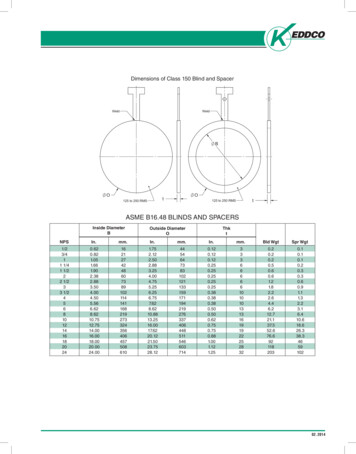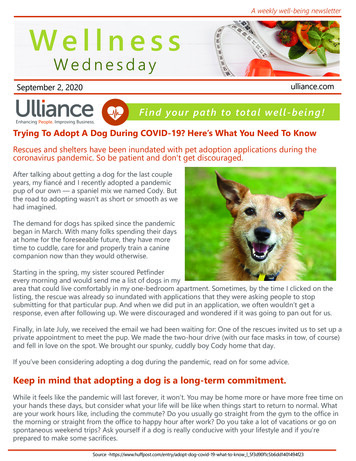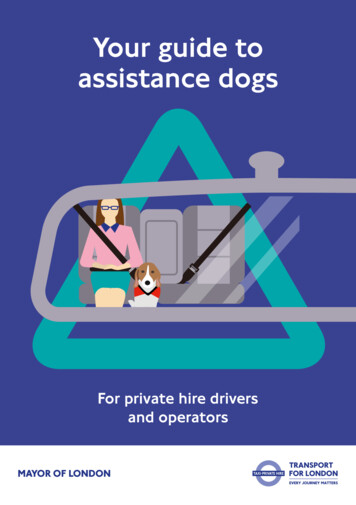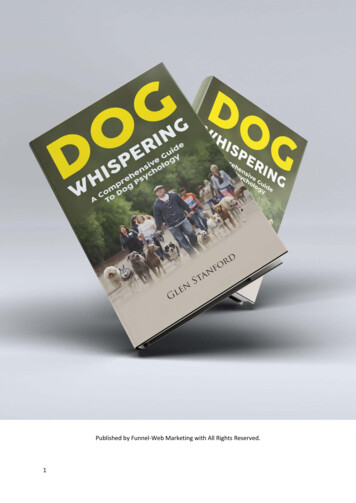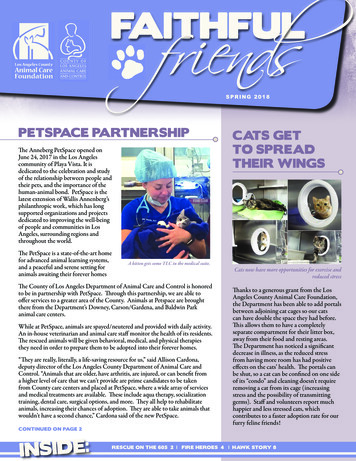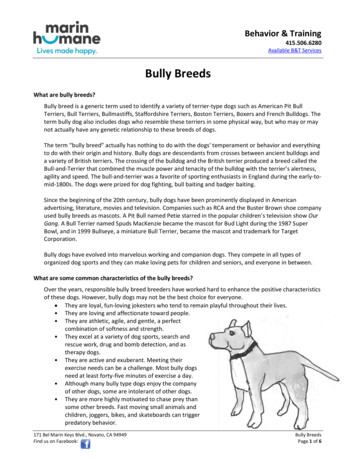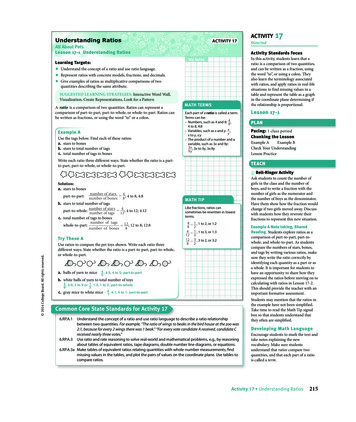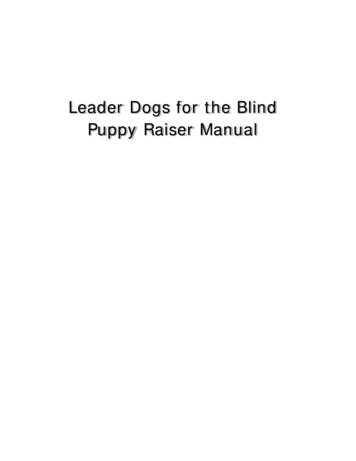
Transcription
Leader Dogs for the BlindPuppy Raiser Manual
Table of ContentsIntroduction . 4Puppy Raiser Contract . 5Leader Dog Contact Phone Numbers. 6SECTION 1: Preparing for a Puppy . 8Preparing for a Future Leader Dog . 8Puppy Pick-Up at Leader Dog . 11Bringing Your Puppy Home . 12SECTION 2: Puppy Raising Basics . 14Feeding. 14Using Your Crate . 17Car Trips . 18House Training . 19Leashes and Collars . 21Fences and Tie Outs . 22Boarding Kennels and Puppy Sitters . 22SECTION 3 – Keeping the Puppy Healthy . 23Evaluating the Puppy’s Health. 23Grooming . 25Important Routine Health Care . 27SECTION 4 – Common Sense First Aid . 29Signs of Ill Health . 30Medical Emergencies . 31SECTION 5 – Raising a Well-Mannered Dog. 33Keys to Effective Training . 33Basic Obedience Foundations . 40Loose Leash Walking. 40Basic Cued Behaviors . 452
Building Duration – Modified Relaxation Protocol . 56Impulse Control Exercises . 59Building Good Decision-Making skills . 66Section 6 – Home and Social Skills . 69Games and Activities that Build Good Social Skills . 69Problem-Solving Unwanted Behaviors . 72Behavior at Home . 77SECTION 7 – Familiarizing the Puppy . 78Puppy Raiser Responsibilities in Public . 79SECTION 8 – Milestones in Growth and Development. 85Age 7–9 Weeks . 85Age 9–13 Weeks . 87Age 13–16 weeks . 88Age 4–6 Months. 89Age 6–9 Months. 90Age 9 Months–Return . 91More About Sexual Maturity . 92SECTION 9 – The Leader Dog Training Program . 94Returning a Future Leader Dog for Training . 95Stages of Training . 96When the Dog Graduates . 97Career Changed Dogs . 98When You Meet a Leader Dog . 100APPENDIX A – Recommended Reading. 103APPENDIX B – Health Records . 104APPENDIX C – Poisonous Plants, Household Substances and Foods to Avoid . 1063
IntroductionWelcome to the Leader Dogs for the Blind puppy raising program. As a puppy raiser, you areproviding an invaluable service to Leader Dog. Your efforts directly affect our ability to provide highquality, well-trained dogs to approximately 200 clients who attend our Guide Dog Training programannually. Raising a puppy demands a huge commitment of time, effort and love on your part. LeaderDog is dedicated to making this experience a rewarding and memorable adventure.Leader Dogs for the Blind is a nonprofit organization located in Rochester Hills, Michigan. Foundedin 1939 by three Detroit-area Lions Club members, we have become one of the largest guide dogtraining facilities in the world. Our Canine Development Center can house up to 350 dogs and ourPolk Residence facility can house up to 24 clients at a time. Over 15,000 clients have graduated withtheir guide dogs since our founding.The puppy you will raise belongs to Leader Dogs for the Blind. All puppies are from Leader Dog’sbreeding colony or donated from select private breeders of Labrador retrievers, golden retrievers andGerman shepherds. The adult dogs in our breeding colony are housed in volunteer host homes. Thepuppy will be your special responsibility to love and socialize as you provide the foundation for itsfuture as a guide dog. Your goal is to raise a happy, confident, trusting, well-behaved dog who excelsin skills necessary to meet the In-For-Training Standards that you will be asked to focus on over theyear with the puppy. As you enjoy the puppy’s companionship, you will be exposing him to a widevariety of social situations, building his resilience and adaptability, and training him to develop theskills he will need to be a successful Leader Dog. Our guide dog mobility instructors depend uponthis dog’s ability to trust and bond to train the dog to successfully work with someone who is blind orvisually impaired.The coming year is a time for growth at both ends of the leash. Puppy raisers expand their own skills,become better dog trainers, model kind, responsible dog handling in public, and act as ambassadorsfor Leader Dog. Social interaction and training are important components of raising a confident, wellsocialized dog.You have made a promise of time, love and commitment in providing a foster home for a FutureLeader Dog. In turn, we are committed to supporting your efforts. This manual is just one way toprovide information and guidance to help you make the puppy's training and socialization enjoyableand successful. It can assist you with preparing for the puppy’s arrival, basic obedience training,prevention of common puppy behavior problems, taking the puppy with you in public places andpreparing for the puppy’s return to Leader Dog.Your area puppy counselor is another important source of help and advice. Puppy counselors areavailable during regular monthly meetings and at other times when needs arise. Puppy counselors areexperienced puppy raisers who are ready and willing to troubleshoot, problem-solve and enjoy thispuppy with you. In addition, you can reach Leader Dogs for the Blind at any time at the numberslisted on the following page.Good luck, have fun and THANK YOU! You play a key role of assisting us in accomplishing ourmission to empower people who are blind or visually impaired with lifelong skills for safe andindependent daily travel.4
Puppy Raiser ContractWhen you pick up the puppy, you will sign a contract which includes some important commitmentsthat you make to help assure the puppy’s health and well-being. These include: Health: Leader Dog provides a mandatory vaccination schedule. Vaccinations, any healthproblems and veterinary visits should be reported to Leader Dog. Safety: The puppy must be on leash or in an enclosed area whenever outside. It must not beleft outside unattended. A crate should be used to keep the puppy safe when it must be leftalone in the home. Socialization and Training: You will receive a weekly “puppy timeline” email withtraining and socialization expectations until the puppy is 16 weeks old. Periodic emailnotices containing questionnaires will be sent to you to complete and submit online. You arerequired to meet with a puppy counselor on a monthly basis. This will require time and travelon your part. If there are no counselors in your area, you will be assigned to an independentpuppy counselor who you will contact on a monthly basis through email, phone calls, Skype,FaceTime or video. You are also expected to follow the guidelines provided within thismanual and the online In-For-Training Standards and video. Our Leader Dog puppies are precious to us. In cases when a puppy raiser cannot meetthese minimum requirements, the puppy may be removed from the volunteer home toprotect its health and safety.Here is a copy of the puppy raiser contract:I (name), hereby agree to accept complete and full responsibility for the puppy named above, to raiseuntil approximately one year of age. I acknowledge that the puppy will at all times remain theproperty of Leader Dogs for the Blind. I will notify Leader Dogs for the Blind immediately in thecase of loss, theft, or death of the puppy. If, for any reason, I am unable to care for or socialize thepuppy as agreed, I will notify the organization. I understand that if I do not take proper care of thepuppy as detailed in the Puppy Raising Manual, Leader Dog shall have the right to remove the puppyfrom my care. I understand the UNDER NO CIRCUMSTANCES am I to allow the puppy to run offleash unless it is in a secure fenced in enclosure, and that the puppy must wear its official Leader DogPuppy Tag at all times. I further agree to assume all responsibility for any damage to my person orestate caused by said puppy while in my care and agree to hold harmless Leader Dogs for the Blindfrom any and all claims that may accrue to me or my family as a result of injury to persons orproperty while the puppy is under my care. Upon completion of raising this puppy, Leader Dogs forthe Blind will place this puppy in a use compatible with the organization’s purpose.5
Leader Dogs for the Blind1039 S. Rochester RdRochester Hills, Michigan 48307Main Office248-651-9011Toll free (use for emergencies)888-777-5332Puppy Development SupervisorPuppy counselor and puppy raising concerns248-650-7114 or ext. 1114Puppy Development CoordinatorPuppy placement, puppy raising concerns248-218-6422 or ext. 2075Puppy Development Assistant Coordinator248-650-7108 or ext. 1154Administrative concerns, questionnaires, puppy returnsCoordinator of Prison Puppies248-218-6686 or ext. 2086Matters regarding puppies being raised in correctional facilitiesManager of Canine DevelopmentProgram questions248-650-7113Canine Development Center Lobby248-650-7115Veterinary ClinicMonday–Friday 8:30 a.m.–4:30 p.m.248-218-6308 ext. 1118Puppy Raiser Advisory CommitteePuppyAdvisory@LeaderDog.OrgThe “voice” of the puppy raiser and addresses concerns.6
PLEASE NOTE: The emergency phone number is our toll free number!Veterinary Emergency after 4:30 p.m. 888-777-5332In case of emergency (possible threat to puppy’s life) after 4:30 p.m.:Call 888-777-5332 or direct line 248-218-6308Press 6 – The prompt for raisers and breeding stock hosts is toward the end for the vetclinic so they will have to be patientPress 1 – voicemailPress 2 – veterinary emergency to connect to on-call veterinarianThis will contact our on-call veterinarian immediately.If you get voicemail, leave a message and the on-call veterinarian will call you back.If your puppy’s life is in immediate danger, contact your closest emergencyveterinary service.Your Emergency Veterinary PhonePuppy Raiser Contract7
SECTION 1: Preparing for a PuppyPreparing for a Future Leader DogAfter your puppy raiser application has been approved, you will likelyhave a wait of several months before a puppy is available for you.Although the wait may seem long, you can use the time to get ready todo a great job with the puppy.Learning Resources for Puppy RaisersLeader Dog has a website section specifically to provide information, updates, instructional materialsand other resources to puppy raisers. This material is located at www.leaderdog.org/puppyraisers/.Below is a summary of learning and support materials available through Leader Dog on our website.Instructional Videos. This series of short videos covers topics of interest to puppy raisers. They are agreat information source for raisers throughout their year of puppy raising.Puppy Raiser Manual. This is the document you are reading. It contains a wealth of information thatwill help you to be an effective puppy raiser. This chapter focuses on the steps you need to take toprepare yourself, your home and your community for the puppy’s arrival. Following chapters coverbasic information about caring for the puppy, keeping him healthy, obedience training, problemsolving and taking him out in public.In-For-Training Standards. Leader Dog has identified specific skills and behaviors that each puppyshould be able to achieve by about 10-12 months of age. These standards focus on skills that give thepuppy optimal chance to succeed at Leader Dog. In addition, the In-For-Training (IFT) Standards arespecific and helpful goals for the puppy raiser. You have online access to the IFT Standards and IFTinstructional videos.Puppy Tales. This bi-monthly newsletter is a treasure trove of Leader Dog news and updates,training tips and information about Leader Dog events and activities. Current and archived issues ofPuppy Tales are available.Puppy Timeline You will receive, via email, a timeline that starts one week prior to picking up apuppy. This timeline continues until the puppy is 16 weeks of age. Each weekly email provides ageappropriate information for teaching the puppy obedience skills and behaviors, as well as suggestionsfor puppy management and appropriate socialization activities.Want to know more? A recommended reading list is included in Appendix A of this manual. Youcan find more information about raising and training dogs, at your local library or bookstore.Before the puppy arrives, you should attend a meeting held by your area puppy counselor. Yourpuppy counselor can help you prepare for the puppy and you can get to know the other raisers in thegroup. They may soon become some of your best friends! By taking this important step you will bepreparing for the time commitment required for meeting your puppy counselor on a monthly basis.Puppy Proofing Your HomeBringing a puppy into your home is much like bringing in a toddler, so “puppy proofing” is essential.Puppies are curious and active and will test their surroundings by tasting; chewing; climbing on,8
under or in; and exploring everything. In a puppy’s mind, the world is a smorgasbord of toys whereanything within reach is fair game for chewing. To puppy proof your home: Pick up or secure trashcans, hampers, books, magazines and breakables.Put household cleaners, poisons, pesticides and medications behind secure cabinet doors orout of reach.Run electrical cords through conduit or attach them to baseboards.Rid the house and garden of toxic plants and poisons (see Section 3 on Puppy Health).Keep cigarettes and ashtrays out of reach.Dispose of bones and keep trash out of reach.Close bathroom doors or toilet lids especially when cleaners or deodorants are used in thetoilet bowl.Keep screens or windows shut especially in upper story rooms.Keep holiday ornaments out of reach—shiny glass bulbs and tinsel are attractive anddangerous.Keep scented candles out of reach. They may smell and taste good, but they can causeintestinal distress and make the puppy very sick.Keep sugar free peanut butter, gum or other products sweetened with xylitol, which ispoisonous to dogs, out of reach.Keep medicines, both human and canine, out of reach.Equipment and SuppliesFood and Water Bowls: We recommend stainless steel bowls that are durable and can be thoroughlycleansed. Plastic bowls tend to get chewed, which makes them harder to clean.Food: Leader Dog puppies require a quality puppy food. The puppy will be accustomed to Pro PlanFOCUS Puppy chicken and rice formula. You will want to have this food on hand when the puppyarrives. You can expect the puppy to eat 40 lbs. or more of puppy food before switching to adult food.If you plan to feed the puppy a different brand of food, please use chicken as the main protein source,and choose a premium food. More detailed information on feeding and foods is found in Section 2.Leashes and Collars: The Future Leader Dog will be wearing a buckle collar with its puppy tagattached when you pick it up. You will need to switch the ID tag to the larger buckle collar when thepuppy is big enough to wear it. (Note: the ID tag should never be attached to the martingale collar).You will receive a long-lasting leather leash, which is easy on the hands. and two martingale collarsto be used during the raising process. See Section 2 for more information on collars and leashes.Crates and Gates: We recommend a portable plastic molded or metal wire crate that will last theentire time you are raising puppies. It should be able to fit an adult dog. A good size is typically 24–26” wide, 36–38” deep and 32–34” tall. Wire crates fold down and travel in less space, provide moreventilation and allow the puppy to see things going on around him. Plastic crates are lighter weight,provide more privacy and puppies are not likely to pull or push things through theside openings. Each has its benefits and drawbacks, so choose the one that best fitsyour lifestyle. Your crate is an essential tool for safe puppy raising and an importantinvestment.Baby gates help keep the puppy safely confined and assist with house training. Youmay want to buy, make or borrow several.9
Appropriate Toys: With so many toys on the market today, how do you decide which are safe andwhich could prove to be fatal? Leader Dog has specific guidelines for toys that have proven safe forour puppies over the years. What follows is a list of approved toys: KONG brand rubber toys (no ropes). A food-stuffed KONG is acceptable for a puppy onoccasion (smear a little peanut butter inside the rim oruse kibble to plug the small end then fill about ½ or ¾of the way with kibble before adding water to soak orfreeze. Use part of the puppy’s normal food for the daywhen stuffing a KONG; treats should not be in additionto the puppy’s normal food intake). Visitwww.kongcompany.com/recipes/ for additional ideasfor stuffing a KONG.The KONG Wobbler food dispensing toy may also be usedwith supervision for feeding a puppy. Nylabone brand toys, appropriate to the size of the dog.All Nylabone packaging shows a weight range for eachproduct, along with a photo of a dog. Look forpackaging that shows larger breeds such as a retriever.You may provide smaller sized products for youngpuppies, but make sure they are removed from thepuppy’s toys as the puppy grows. Products listed asdental chews are not appropriate for puppies over 6months of age. When purchasing a Nylabone toy, lookfor the “Durachew” labeling, which reads “non-edible for powerful chewers.” Do notpurchase Nylabone toys that are edible, have edible parts, come apart, or are flexible. Whole elk antlers, never the “split” type. Leader Dog veterinarianshave approved elk antlers for Future Leader Dogs only. They arenot approved for Leader Dogs matched with a client. The Tux and Hurley toys from West PawDesign’s Zogoflex line of toys. The Topl treatdispensing toy may be used with supervisiononly. The wishbone shaped bone from Benebone,purchased in a size suitable to the weight of the puppy.Unacceptable Toys: Never buy toys that have bells or pieces that can be chewed off and swallowed.This includes Nylabone products with removable pieces and KONG products with fabric or ropes.Other toys that are unacceptable are: rubber toys with squeakers, rope toys (the strings can becometangled in the intestines and cause irreparable damage), soft plush or stuffed fabric toys, rawhidebones and real bones. Rawhide bones can become impacted in a puppy’s digestive tract and realbones can splinter and stick in a puppy’s throat. Socks, old shoes, towels or gloves should not be usedfor toys because they confuse the puppy about what he can chew on and possibly encouragedestructive behaviors later in life. Should you have a question on whether or not a particular toy issuitable for a Future Leader Dog, please contact your puppy counselor or the puppy developmentdepartment at Leader Dog.Preparing your Community for a Leader Dog PuppyYou will want to take the puppy out with you in public to provide him with a variety of socialexperiences. Before getting the puppy, visit some local businesses to explain the Leader Dog puppy10
raising program and to get permission for the puppy to accompany you into the business. FutureLeader Dogs do not have the same public access rights provided to working Leader Dogs, so alwaysask first! You may also want to find a local veterinarian who may provide services at a reduced rate.A letter is included in your puppy packet to use for veterinarians when discussing possible reduced orfree veterinary visits for a Future Leader Dog. If you live close to Leader Dog, you can bring thepuppy to our veterinary team for its health care needs. If you are likely to need a boarding kennel inthe coming year, take time to find a good one now.Dog Licenses and IdentificationCheck with your local government regarding the need for a dog license. A license may or may not berequired for the puppy. In some places a license for a guide dog or future guide dog may be free ofcharge.Please get a personal ID tag for the puppy that includes your name, phone and/or address. Althoughthe puppy should NEVER run loose, a tag is a good idea for the rare emergency when the puppy getsaway, such as a car accident or broken leash.Naming a Future Leader DogWe prefer that the dog is named a two-syllable word that starts with a hard consonant such as Casey,Trudy, Buddy or Kelly. One syllable names like Jake, Scamp, Ruff and Mack are also suitable. Donot choose a name that sound like a command or commonly used word (i.e. “Kit” sounds like “sit,”and “Ray” sounds like “stay.” Dogs can hear very well but are not great at differentiating betweensimilar sounds). Names that are long or difficult to say can make it difficult for our instructors orvisually impaired clients, who repeat the dog’s name many times a day. Keep in mind that we do notknow whom this puppy may go to in the future, so common human names (i.e., Pete or Jacob) maycause conflict if the dog is matched with a client with the same name. Leader Dog reserves the rightto request a name change should we feel the name is unsuitable for any reason.Puppy Pick-Up at Leader DogLeader Dog will contact you when an available puppy is 1–3 weeks of age to confirm that you areprepared to take on this year-long responsibility. An appointment will be scheduled for you to pick upthe puppy.A leash, collars and toys will be provided for you when you pick up the puppy. Bring a small crate sothe puppy can travel safely home unless you have a passenger along who can monitor the puppy onthe vehicle floor. If you are traveling far distance, bring a bowl for water or food.At Leader Dog you will read and sign a puppy raiser contract and checklist. A teammember will discuss health records, vaccination dates and answer any questions.Finally, you will meet the new puppy! This is a good time to have a camera ready!Leader Dog Puppy ID TagEach Future Leader Dog will have his own numbered identification tag which needs to be attached tohis buckle collar at all times. Leader Dog uses this numbered tag to track a puppy’s growth and healthhistory from birth throughout his lifetime.11
Future Leader Dog Bandanna and JacketYou will be supplied with a Future Leader Dog bandanna and jacket. The puppy shouldalways wear his bandanna or jacket at all times in public. Along with the Leader Dog IDtag, this helps identify him as a Future Leader Dog and clarifies his presence in stores orother public places. The puppy’s jacket and ID tag do not give or guarantee any accessrights. However, they clearly identify him as being an official part of the Leader Dogprogram, making it possible for you to request storeowners to allow you and the puppy toenter. The storeowners are asked to only let puppies in that are wearing either theirbandanna or jacket and their ID tag. The puppy should not wear any other bandannas,costumes or other items that are not Leader Dog issue in public.As the puppy raiser, you may have the puppy’s name sewn onto the jacket or bandanna if you sochoose. You may not alter the bandanna or jacket in any other way (patches, buttons or any other typeof written information).Bringing a Puppy HomeAllow plenty of time to let the puppy “park” (relieve itself) before leaving Leader Dog. On your wayhome, have a safe place for the puppy to travel. A small crate is necessary unless you have passengersto hold the leash while the puppy rides on the floor. Please never drive a car with the puppy on yourlap.When you arrive home, take the puppy to his designated “park” area (see House Training in Section2). Give the cue to “park.” Once he parks, give immediate praise, letting the puppy know he has donewell. You are now ready to take the puppy into your home and slowly introduce him to his newsurroundings. Limit the puppy to just one or two rooms at first. Allowing the puppy too muchfreedom in the house greatly increases the likelihood of “accidents.”Introduce the puppy to all the things in the room. When he finds something inappropriate, distracthim with an upbeat tone of voice (“puppy, puppy, puppy!”), provide an appropriate toy and thenreward the puppy with a piece of kibble and praise. Remember that this new puppy is like a two-yearold child—he will investigate everything and has a very short attention span. Temporarily put up orremove anything that could be dangerous to him. Trying to prevent inappropriate behavior is mucheasier than trying to correct problem behavior once it has become a habit.Slowly introduce the puppy to each room in the house over the next few days or weeks. Remember todistract him from inappropriate activity, and reward and praise for good behavior. Never leave thepuppy loose and unattended for at least the first month or two.If you have other animals in your home, introduce them tothe new puppy one at a time in a controlled setting. Keep thepuppy in his crate or behind a
Socialization and Training: You will receive a weekly “puppy timeline” email with training and socialization expectations until the puppy is 16 weeks old. Periodic email notices containing questionnaires will be sent to you to complete and submit online. You are required to meet wi
